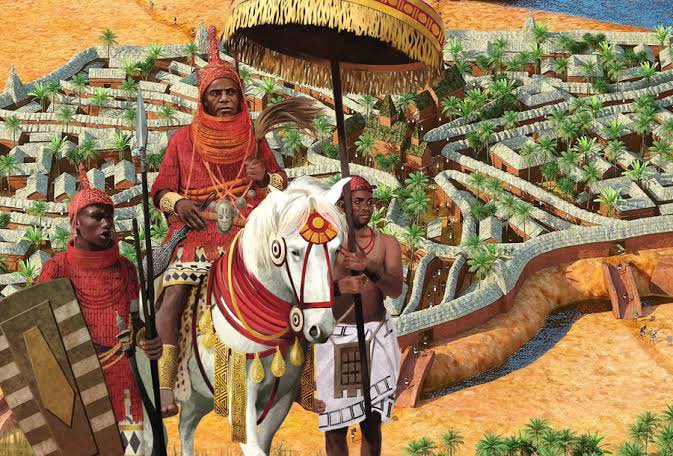Ancient Ghana (Wagadu)
___
Ancient Ghana existed in now Mauritania, Senegal, and Mali between 700CE – 1240CE commonly known as Wagadu, its first capital city was Koumbi Saleh, the biggest city south of the Sahara Desert. At its peak, it was home to between 15,000-20,000 people.



___
Ancient Ghana existed in now Mauritania, Senegal, and Mali between 700CE – 1240CE commonly known as Wagadu, its first capital city was Koumbi Saleh, the biggest city south of the Sahara Desert. At its peak, it was home to between 15,000-20,000 people.




The name Ghana derives from a local title meaning king. This kingdom was an important stop along the trans-Saharan trade route which connected African societies in the Sahel to the markets found along the coastlines of the Mediterranean Sea and the trans-Saharan gold trade. 

Consequently, the reputation of Ghana spread to North Africa and Europe, where it was described as a fabulous land of gold. Trade was facilitated by the abundance of iron, copper, gold, ivory & easy access to the Niger and Senegal Rivers and their tributaries from 6th-13th Cen. 

They specialized in the trade of gold and kola nuts (the latter of which became the secret ingredient in Coca-Cola centuries later).
https://twitter.com/Joe__Bassey/status/1297941957898121218?s=19
The Sudan region of West Africa (not to be confused with the modern state of that name), where the Ghana Empire would develop, had been inhabited since the Neolithic period as is evidenced by Iron Age tumuli, megaliths and remains of abandoned villages. 

The Ghana Empire was mostly composed of the Soninke (aka Sarakole) people, who spoke Mande (aka Mandingo) and who occupied the area of savannah between the Niger River (to the southeast) and Senegal River (to the southwest). 



Cereals such as red-skinned African rice and millet were grown with success, as were pulses, tuber and root crops, oil and fibre plants, and fruits. Fishing and the herding of cattle and goats were other important sources of food. 

Local deposits of copper were exploited and used for trade, while metalworking in the region, as indicated by archaeological finds, dates back to at least the 6th century CE. 

Ghana Empire was most Koumbi Saleh according to the Arab traveller Al-Bakri, visiting near the end of the empire’s history in 1076 CE, describes the capital as being surrounded by wells, walls and with irrigated fields where many vegetables grew
https://twitter.com/Joe__Bassey/status/1307726595260592139?s=19
Conglomerate of villages ruled by a single king, the empire prospered thanks to a well-trained army which had cavalry units and access to raw materials such as iron ore to make its weapons and gold deposits to pay its soldiers. 

Meanwhile, The Ghana king was an absolute monarch and the state’s head of justice and religion, The king rely on his advisors, from the 11th CEN CE, even recruited Muslim merchants to act as interpreters and as officials who helped manage the economy and keep track of the goods. 



The Kingdom of Ghana’s decline was cemented when it became part of the kingdom of Mali when it was defeated by Sundiata Keita in 1235 CE, he would go on to found the Mali Empire (1240-1645 CE), the largest and richest empire yet seen in Africa.
Also read..
Also read..
https://twitter.com/Joe__Bassey/status/1300678387615371264?s=19
To know more about ancient African civilization and history check my likes and follow me to see my future post. 

@threadreaderapp unroll
• • •
Missing some Tweet in this thread? You can try to
force a refresh






























